Leia a review às Duevel Planets e Enterprise em português
Some journeys begin without a map.
One day you find yourself listening, and it’s no longer merely music; it has become space.
When I first set up a pair of Duevel loudspeakers at home, I realised that I was facing something entirely different from anything I had known. It was the first step in an adventure, a journey where music stopped being something I controlled and became something that surrounded and absorbed me.
Only one other system had ever captivated me in quite the same way: for the sheer aliveness of its sound: organic, physical, almost breathing. And all this without crossing into the realm of absurd prices (for most). That system, too, had been simple: full-range loudspeakers, a single-ended class-A amplifier, a SACD player for conversion and a music server. Nothing transcendent.
This is the first of two chapters in a journey through omnidirectional sound: a concept that transforms listening into a spatial experience. Over almost a year, three Duevel models passed through my listening room, thanks to the generosity of a friend and the support of SoundIt, the brand’s representative for the Iberian Peninsula.
What began as curiosity became discovery.
The Omnidirectional Sound
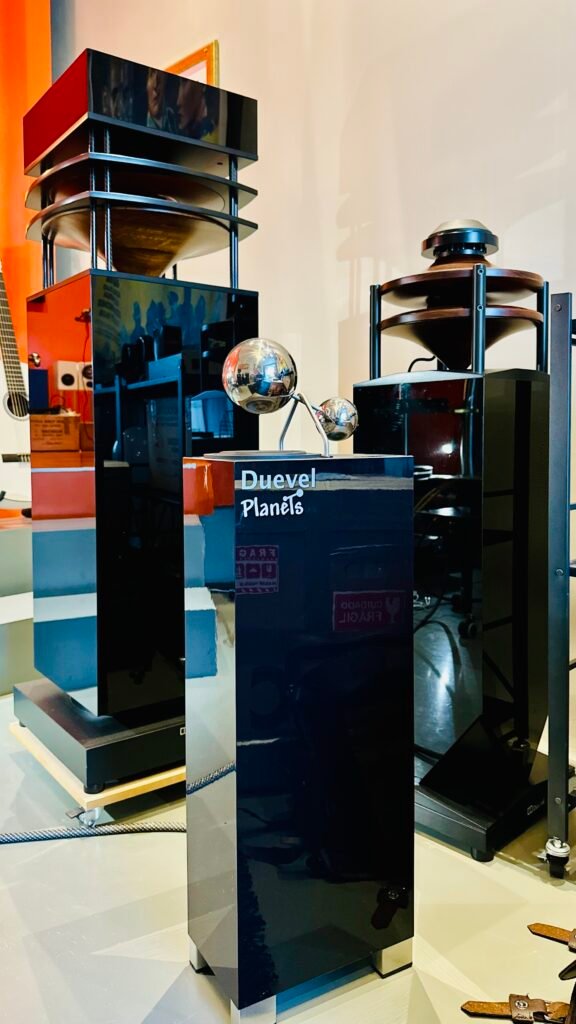
Listening to music through omnidirectional loudspeakers is not merely listening, it is allowing every note, every sound, every shimmer of reverberation to inhabit the room. This architecture has a peculiar power: it turns a space into a sphere of sound where each detail acquires its own tangible presence. It hardly matters where you sit: on the sweet spot, leaning against a wall, or even upside down (that one I’ve yet to test).
My journey with Duevel began with the Planets, which Markus Duevel affectionately calls the Appetiser in his native tongue. Between my first home sessions, a visit to SoundIt in Leiria, and many hours spent with a friend who owns a pair of Bella Luna, I gradually built a sensorial understanding of what it means to hear music through omnidirectional loudspeakers.
As Fernando Pessoa, a portuguese poet, once wrote: “primeiro estranha-se, depois entranha-se” (At first one is estranged; then it seeps in).
That line proved prophetic.
This text is the chronicle of that journey: from the Planets, through the Enterprise, and on to the magnificent Bella Luna, with a stop at the Sirius, the brand’s flagship.
Duevel represents far more than an unusual loudspeaker design.
While most designers chase the holy grail of perfect directionality, Markus Duevel embraces dispersion as a language. Sound ceases to be a triangle and becomes a sphere. Focus yields to immersion. Space, once a mere backdrop, becomes part of the instrument.
What this brand truly does is challenge the modern paradigm of listening, by enfolding the listener within the music itself.
Duevel Planets — The Appetiser
At first glance, the Planets reveal an elegant simplicity: slender, just 84 cm tall and weighing 11 kg, with clean lines and two suspended metal spheres positioned above the upward-firing drivers. The look is unfamiliar at first, yet discreet and solid. Perfect for those who prefer their equipment to inhabit the room quietly, not dominate it.
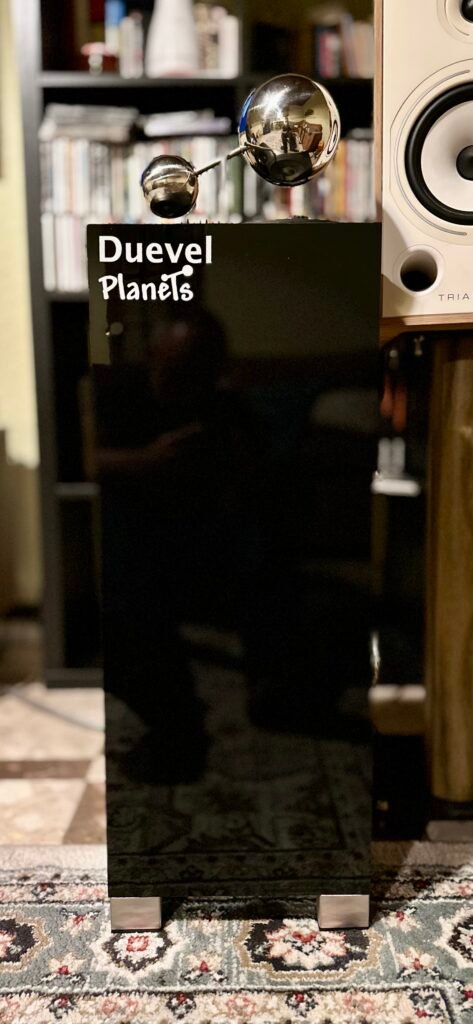
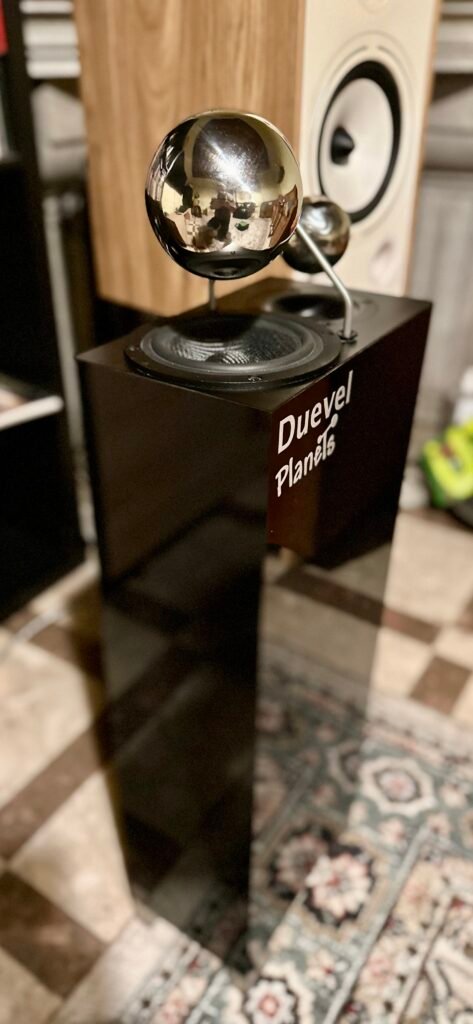
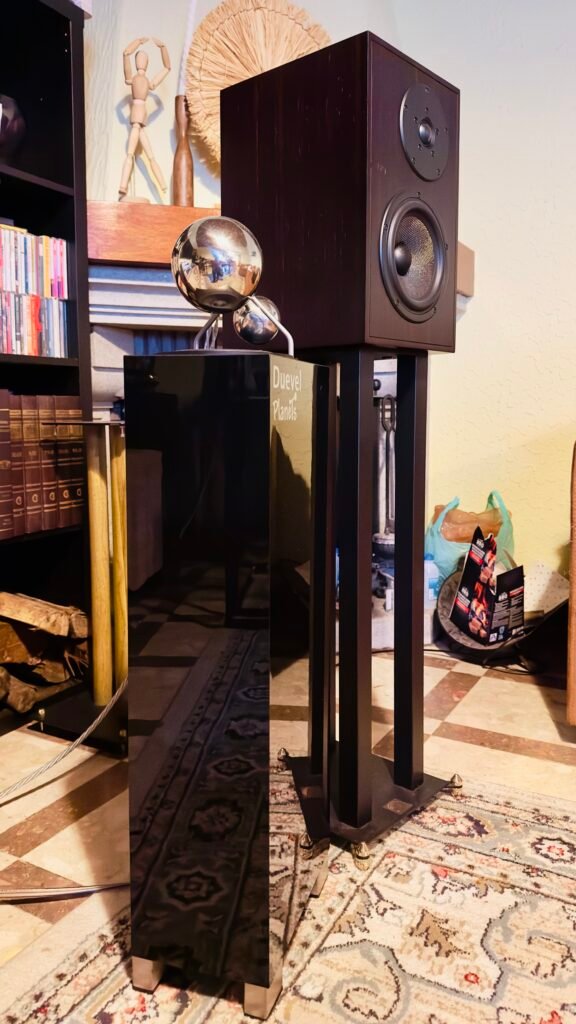
Their true character emerges the moment the music begins. I paired them with my resident amp, the Accuphase E-280, the TEAC AP-701 (in for review), and the Pier Audio MS-480SE, to help gauge price-to-performance context. In every combination, they projected a soundstage whose immersion, though expected, still surprised me. Each instrument settled naturally into position, forming a sonic sphere that flooded my room.
I also tried them with the Marantz M1, which proved under-powered.
The Character of the Planets
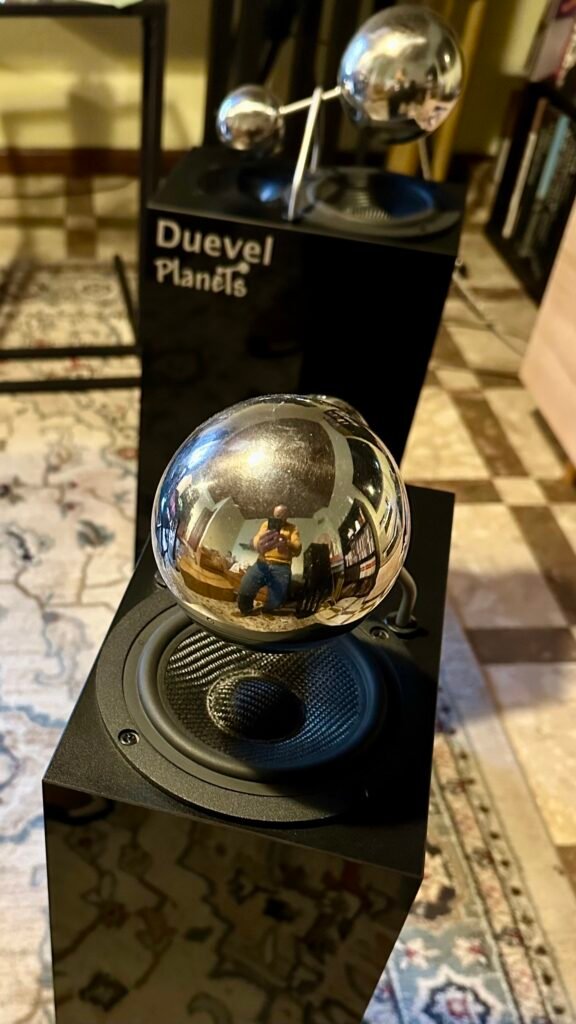
The Planets are Duevel’s conceptual DNA in its rawest form: sound breathes in all directions. The result is not the conventional stereophonic image, but a field in which the listener relinquishes control and accepts space itself as part of the performance. They may not please the analytical ear, but they will delight the musical soul.
From the simplest pop track to the most refined acoustic piece, everything plays on equal footing. What distinguishes the experience is music taste, not recording quality.
The Planets exist for listening, truly listening, provided they’re driven by an amplifier with sufficient muscle. Percussion strikes with lifelike attack; the midrange has pleasing body, especially on female vocals; the treble is quick and airy, reminiscent of horns speakers, but without their typical fatigue.
The Engineering Behind the Magic
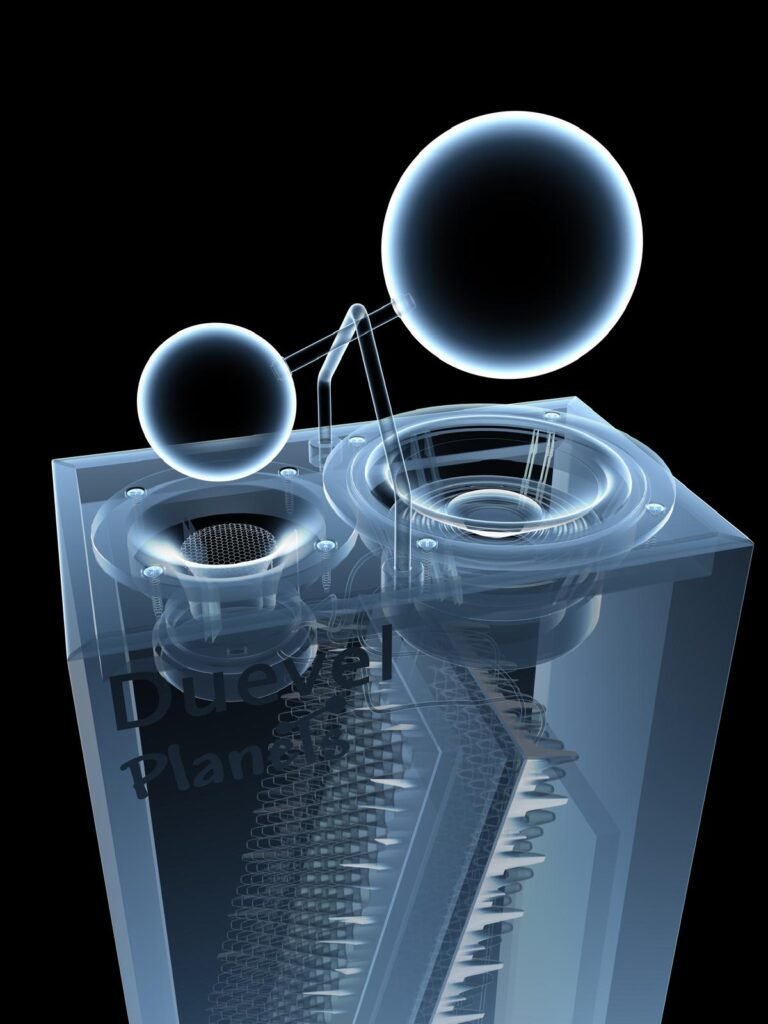
The secret lies in controlled reflection. The metal spheres deflect the upward-firing sound, scattering it outward like ripples on a lake. This is what allows each note to hang in the air rather than be projected straight at you.
Amplifier synergy is crucial. The Planets demand both grip and stamina, and invites you to turn the volume knob further than usual. Transparent, precise electronics let them shine. With the Accuphase, the result was natural and honest detail: texture, breath, presence, all integrated and embodied, lacking only a hint more cohesion (my inner nit-picker speaking).
Their woofers seemed slightly less agile than their tweeters, which, to my ear, are the speakers’ strongest asset. The hybrid design of the Pier Audio 480-SE added a whiff of valve sweetness and liquidity in just the right proportion. And conveniently, the price also matched: around €1,300, similar to the French integrated, plus shipping and finishing.
Strengths and Limitations
Strengths:
Ideal for listeners who value freedom of position. More than an entry-level model, they are a promise of what omnidirectional architecture can offer. Natural timbres, agile percussion, and a particular charm in female vocals.
Limitations:
Not for everyone. Ears trained on conventional directional speakers may find them puzzling. They require a firm-handed amplifier. The Marantz M1 fell short; the Pier Audio and Accuphase both rose to the occasion, though anyone owning an Accuphase might seek speakers more on par with its pedigree.
Conclusion — The Planets

The Duevel Planets stand out for their expansive, three-dimensional soundstage that embraces the listener without tethering them to a single seat. Their sound is natural, warm and forgiving, ideal for percussion, acoustic recordings, and female voices with that beguiling timbre.
Compact and available in a variety of finishes, they integrate easily into any living space, offering excellent value and remarkable placement flexibility (they prefer a solid base, as their downward-firing ports benefit from firm grounding).
A fine match was the Pier Audio MS-480SE. With the Accuphase, the result was even happier, though clearly they play in a different league. Listeners used to directional systems may miss a certain pinpoint focus or sense a faint veil between themselves and the music, but that, in truth, is their charm: they are different.
All told, the Planets are a captivating invitation into the world of omnidirectional listening.
Enterprise — The Main Course
At first sight, the Enterprise seem like the elder sibling of the Planets. Recognisably of the same lineage, yet clearly more mature. The twin metallic spheres give way to a small conical deflector above the tweeter, and a broad ring around the woofer, which now grows from 150 mm fibre to 170 mm paper. The tweeter, too, gains a horn flare reminiscent of Duevel’s top models.
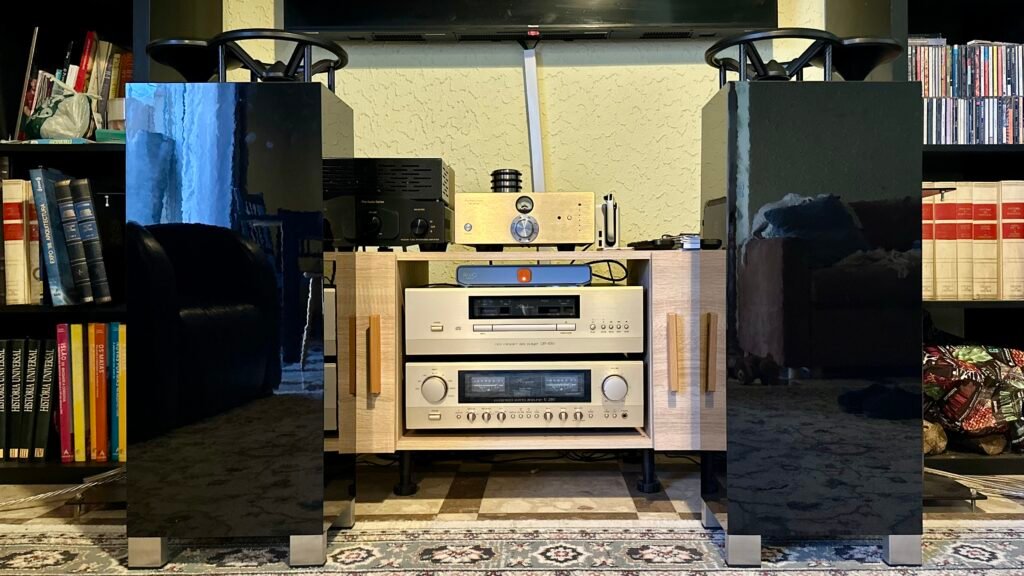
But in sound, the Enterprise are a different creature altogether: more adult, demanding, alert. They appreciate a generous gulp of power, yet they repay it with scale, control and authority. They manage distortion with a composure that lesser designs rarely muster.
A Step Forward in Sound
Everything the Planets can do, the Enterprise can do more, and better.
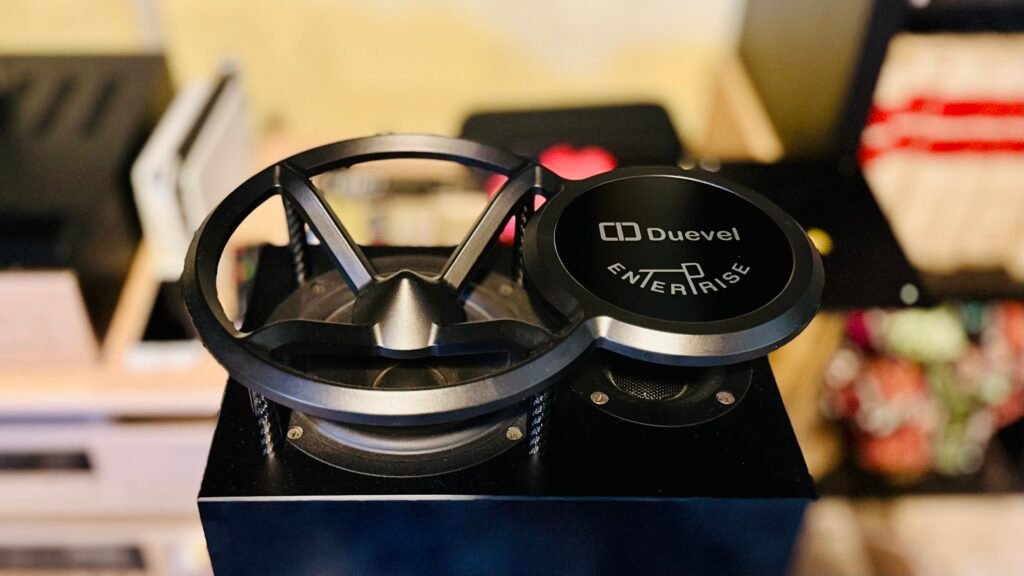
They largely correct their smaller siblings’ slight reticence in the lower midrange at moderate volumes, while preserving that uncanny omnidirectional “voodoo”, now with more attack and longer decay. The move from fibre to paper cones may have granted them extra coherence and warmth.
The satisfaction of hearing drums and percussion through them is complete. Now we’re on the same wavelength! The Enterprise possess real muscle, and when the volume rises, they’ll happily make your floorboards quiver.
Strengths and Limitations
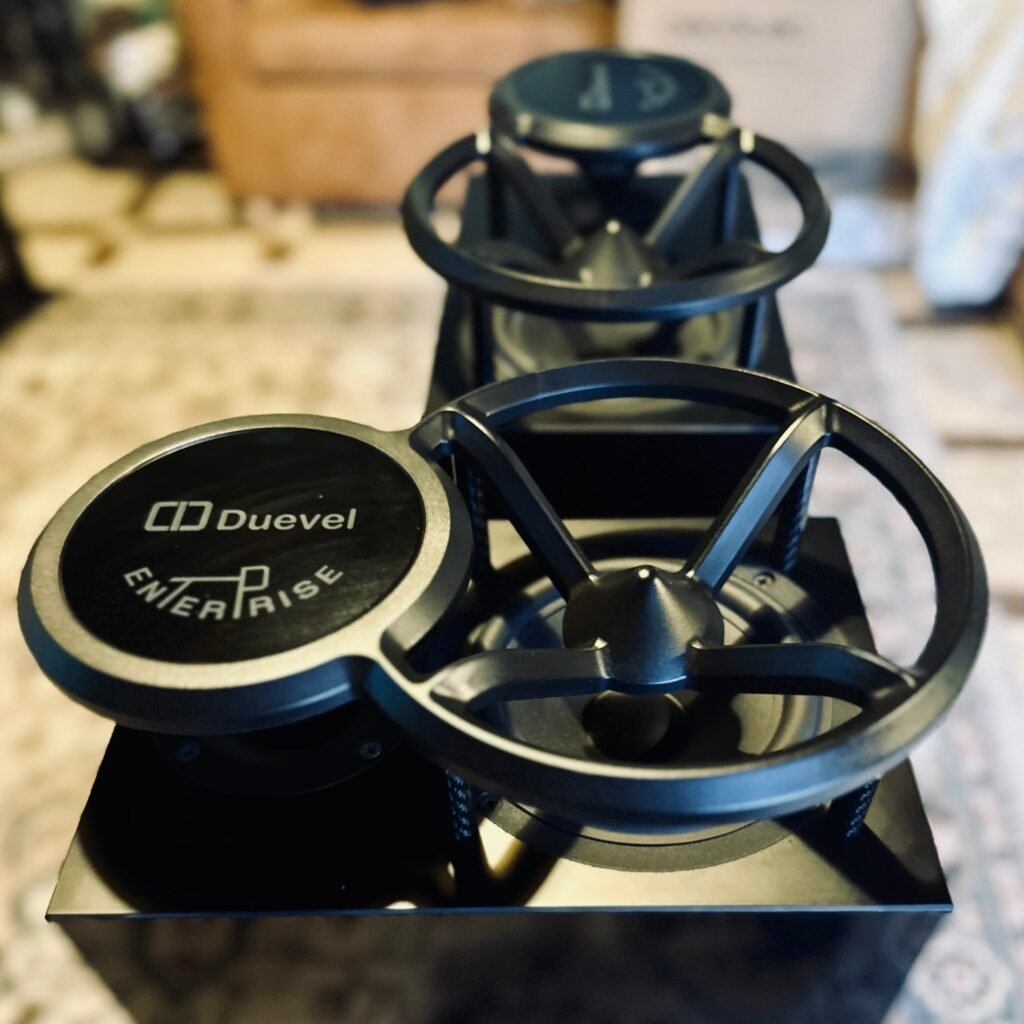
Strengths:
Everything the Planets have, multiplied, with greater coherence, drive, and refinement. They bring scale and confidence to the Duevel signature.
Limitations:
The omnidirectional architecture itself still carries small trade-offs. A perfect point-source omnidirectional design would offer even greater precision, something achieved in the Bella Luna and Sirius. Perhaps the next step in the lineup, the Galaxy, which shares the same type of chassis as the Enterprise but adopts a point-source architecture, could address the minor shortcomings.
The Enterprise are a superb choice, but having lived with the Bella Luna, I know how the story continues. Price: €2,400 plus shipping and finishing.
Conclusion — The Enterprise
The Duevel Enterprise distinguish themselves by their dynamic, detailed, and balanced sound, with round, well-integrated bass born of a design that marries dispersion with tonal coherence. Elegant and discreet, they merge effortlessly into, both the physical room, and the musical soundstage, creating immersion without intrusion.
Their efficiency is another advantage: they don’t demand heroic amplification, though they thrive on a current-rich partner. Placement is forgiving; bass control remains poised even close to walls, though, like their sister Planets, they prefer firm footing.
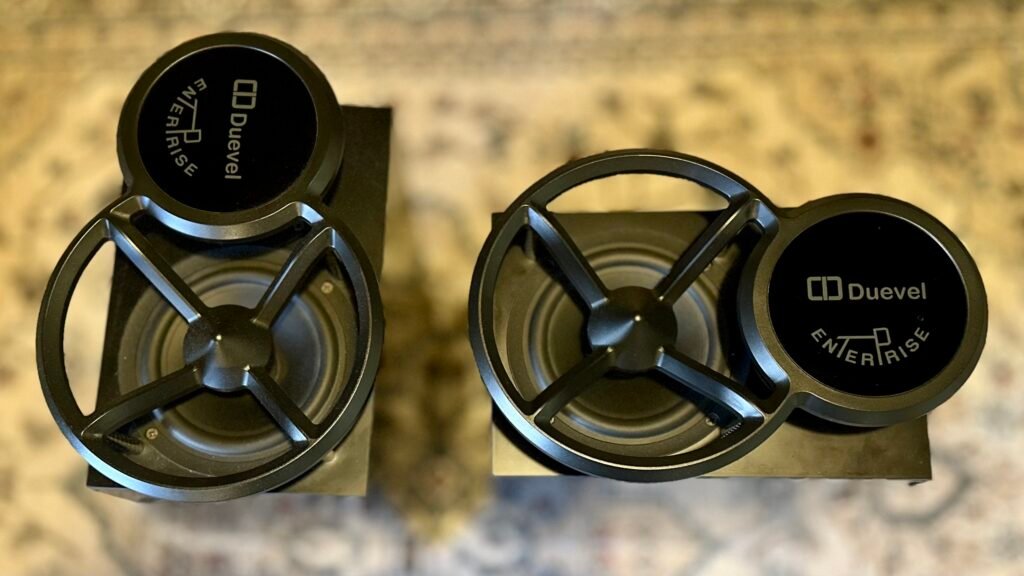
They cost more than the Planets, but the leap is amply rewarded in sonic maturity. Their liveliness and crisp personality may not appeal to every listener, so a personal audition is advised.
In sum, a refined and solid proposition: broad dispersion, minimalist aesthetic, balanced performance. From here onwards, Duevel demonstrate that the omnidirectional concept can coexist with rigour and scale. It’s no longer just an experiment, it’s a statement.

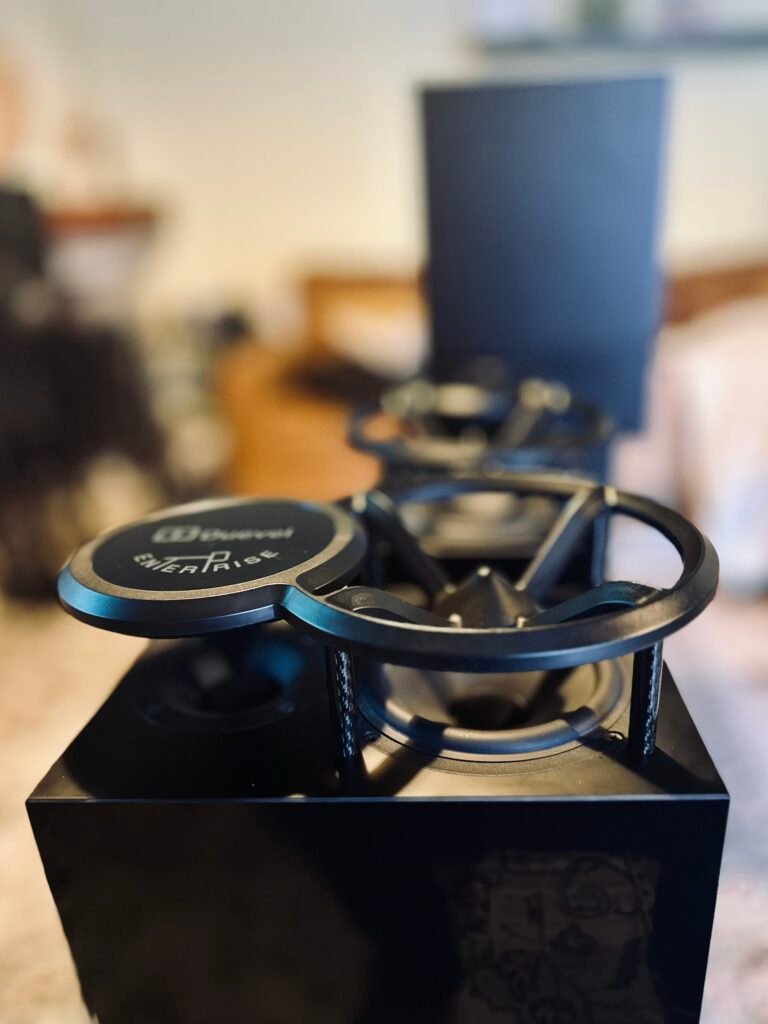
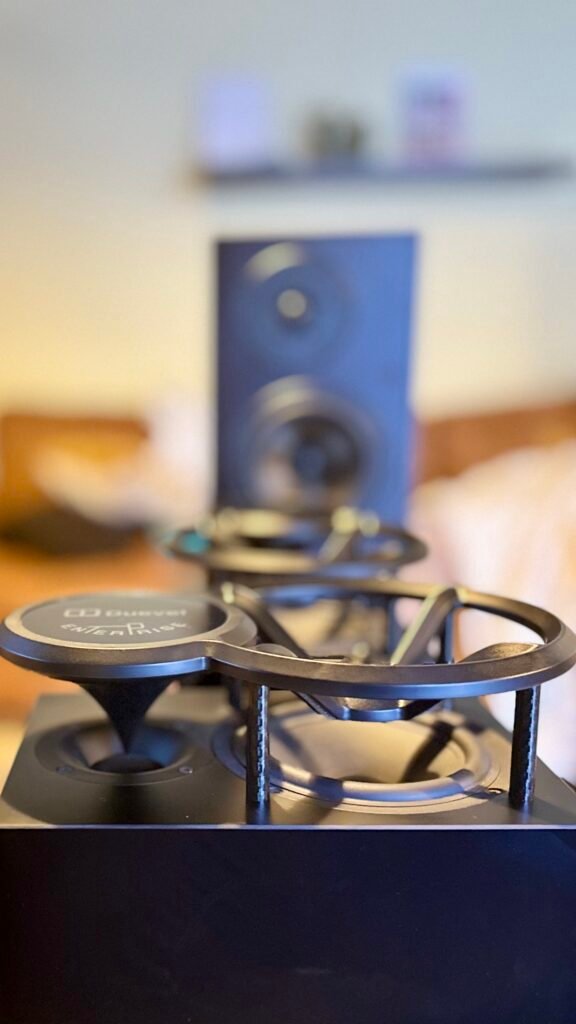
The Visit to SoundIt Store
SoundIt, the sole official Duevel store in the Iberian Peninsula, lies in the Portuguese city of Leiria. In January I made a small pilgrimage there to explore the space and to meet Kai Schlösser, the man behind the project.
Listening sessions in unfamiliar rooms rarely allow for definitive judgments, but the experience was invaluable. I was able to hear the flagship Sirius and compare, under similar conditions, all four models of the range present at the time.
The front end was a Kuzma Stabi R turntable with a Ref 313 tonearm and Sumiko Virtuoso DTI cartridge, feeding Lyric valve amplification, and, of course, the sonic sculptures of Markus Duevel.
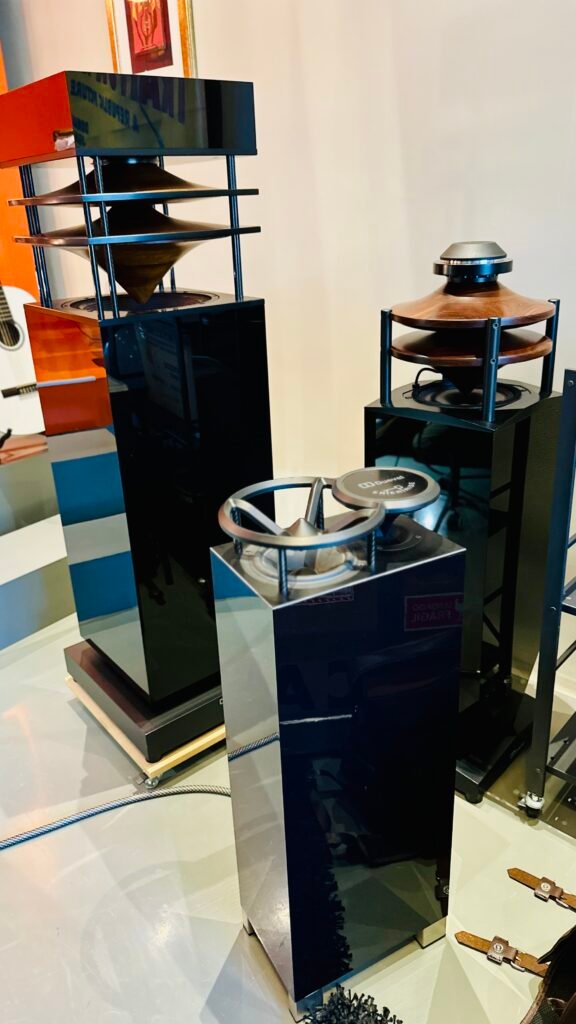
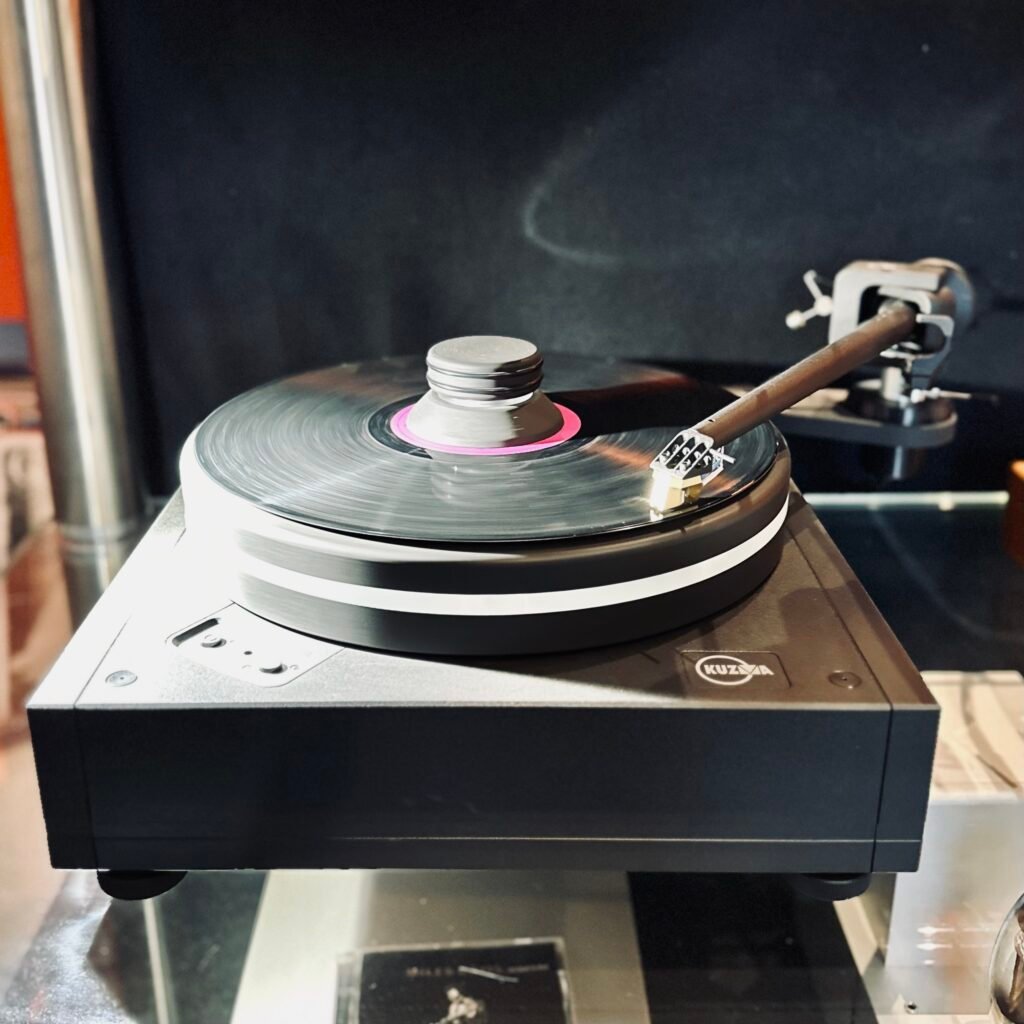
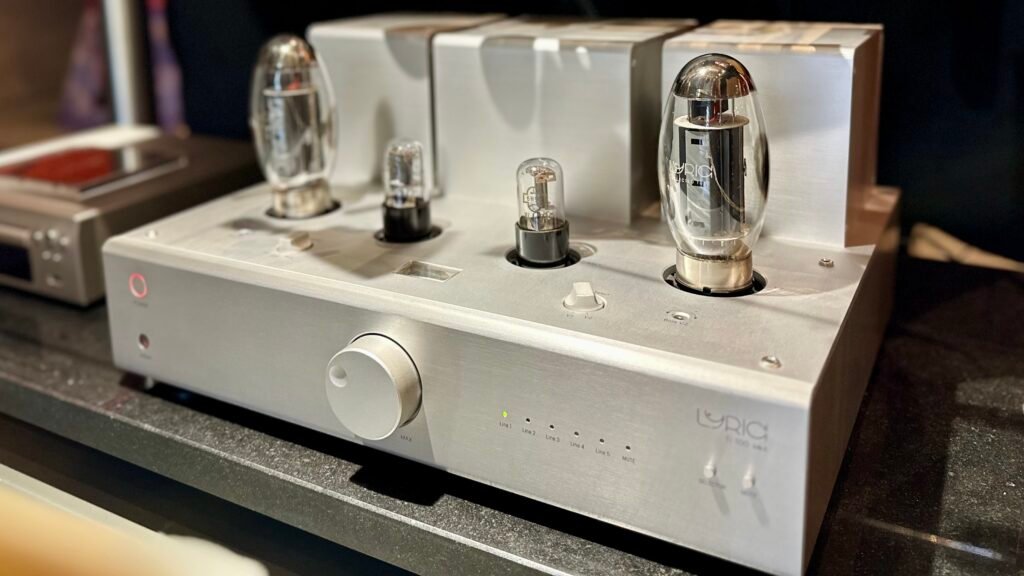
Sirius — At the Summit of the Philosophy
Hearing the Sirius and Bella Luna, both true point-source designs, reinforced the impression I had taken from earlier encounters: a concert-hall experience where the room itself dissolves into a dome of sound.
The Sirius asks us €27,000 per pair, or €45,000 with beryllium tweeters. In person they embody the culmination of Markus Duevel’s philosophy: point-source geometry and absolute temporal alignment. The purest translation of the brand’s ideal, the total illusion of suspended space.
During the session we roamed through our test tracks. “Stimela (The Coal Train)” by Hugh Masekela unveiled a vast soundstage and exemplary focus; “Speechless” by Laurie Anderson revealed the joy of abundant current and magical spaciousness. Every track confirmed the same truth: the Sirius do not merely reproduce music, they conjure an entire sonic universe.
What Comes Next
The Planets showed me space.
The Enterprise revealed power.
The Sirius offered a glimpse of Olympus.
But destiny still held another experience in store: the Bella Luna.
A friend, in the midst of refurbishing his listening room, offered me the chance to live for a few days with his system: Duevel Bella Luna, Lyric Ti 100 Mk II, and Denafrips Pontus 15th Anniversary Edition. I immediately answered: “Yes, of course.”
The difference was immediate and palpable.
And then, the Bella Luna…

To be continued in Part II — “When Sound Disappears and Only Music Remains.”
The Planets and Enterprise used in this review were kindly provided by SoundIt.
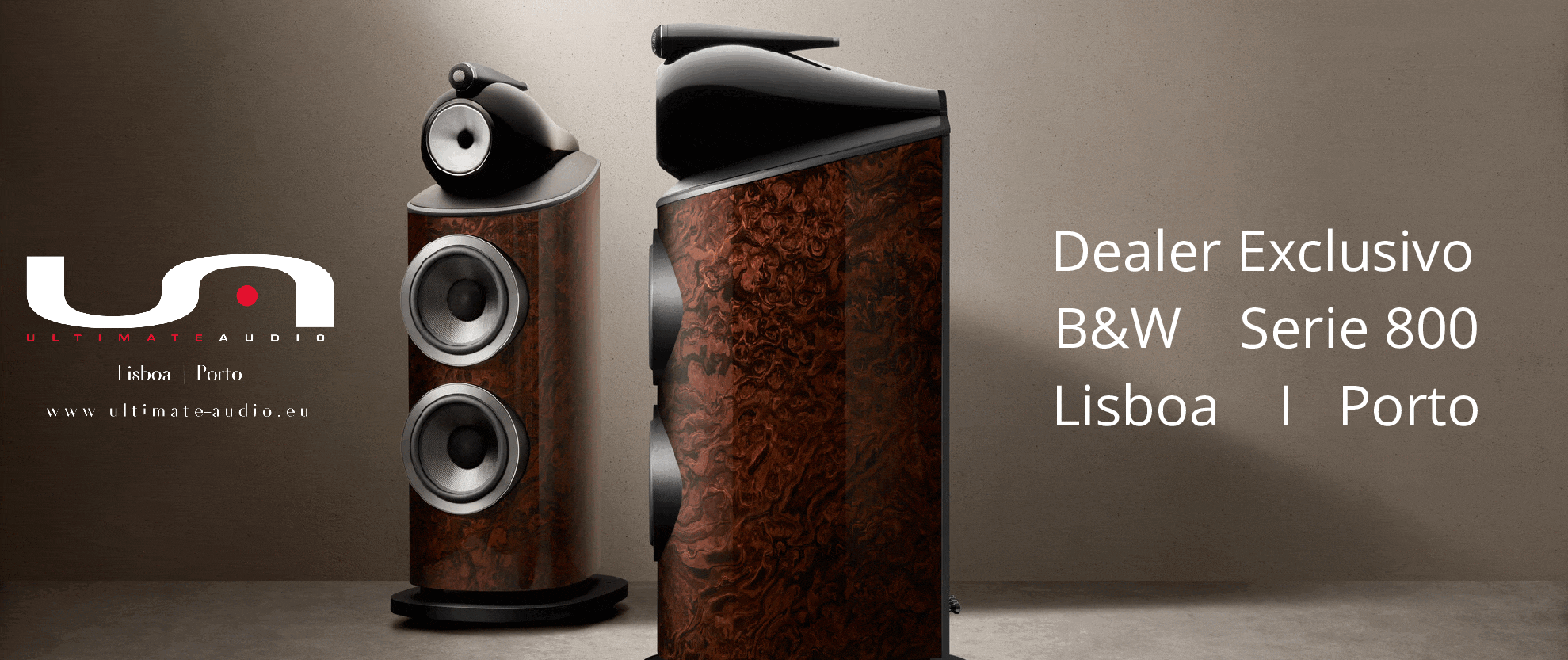
Pingback: Uma Viagem de 360º Pelo Som. 1ª Parte: O Aperitivo e o Prato Principal, Duevel Planets e Enterprise - MoustachesToys | High-End Audio Reviews & Experiences
Os comentários estão fechados.